Study on the Diffusion Parameters of Newtonian Fluid in High-Pressure Jet Disturbance Grouting
Abstract
1. Introduction
2. Diffusion Law
2.1. Diameter Formula for the CCJG
2.2. Modeling the Climb Height of Slurry
3. Development of a Self-Rotating Nozzle
4. Experiment
4.1. Material and Equipment
4.2. Test Design
4.3. Test Implementation
4.4. Result and Discussion
4.4.1. Influence of Grouting Parameters on the Volume of the CCJG
4.4.2. Influence of the Grouting Parameters on the Compressive Strength of the CCJG
4.4.3. Analysis of the Grouting Diffusion Law of Self-Rotary Jet Grouting
5. Conclusions
- This study introduced a theoretical model for estimating the diameter of the CCJG in high-pressure jet grouting. Field tests corroborated the formula’s applicability. In addition, a formula for computing the grout’s climb height on the pile side was derived, grounded in the rheological equation for a Newtonian fluid.
- An optimization experiment for the grouting parameters was conducted, analyzing the impact of pivotal grouting parameters like the DP, DT, GP, and W/C on the CCJG’s volume and strength. It was established that DP and DT are the principal determinants of the CCJG’s volume. The largest CCJG volume materializes at a DP of 19 MPa and a DT of 10 min. Conversely, the W/C and DT predominantly influence the CCJG’s strength, with the peak strength occurring at a W/C of 0.6 and a DT of 10 min.
- The dynamics of grout diffusion were scrutinized through compressive strength tests on core samples from the CCJG. The tests revealed varying stabilization forms of grout in the soil during the grouting process, with the slurry diffusing outward from the grouting hole’s center, stabilizing the soil through replacement, mixing, and compaction.
Author Contributions
Funding
Data Availability Statement
Conflicts of Interest
Abbreviation
| Symbol | Meaning |
| Dp | diameter of the CCJG |
| xL | limit of the cutting radius |
| ηa | amplification factor when considering compaction grouting |
| vo | outlet velocity of the high-pressure water at nozzle position |
| d | nozzle diameter |
| vL | critical failure velocity of the soil |
| Pn | inlet pressure at nozzle position |
| γ | weight of the liquid |
| g | gravitational acceleration |
| μ | flow velocity coefficient of the nozzle |
| Patm | standard atmospheric pressure |
| β | characteristic velocity, with a value range of 1.5 to 3.0 |
| soil mass resistance | |
| σ’ | effective stress |
| φ’ | effective friction angle |
| P | pumping pressure |
| R | diameter of the CCJG after compaction |
| Ir | rigidity index, with a value range of 10 to 40 |
| v | Poisson’s ratio |
| E | elastic modulus |
| c | cohesion |
| q | initial stress in the soil |
| k0 | lateral pressure coefficient |
| τ | compressive stress |
| η | dynamic viscosity |
| λ | compressive rate |
| r | thickness of the microelement |
| r0 | radius of the pile |
| r1 | distance from the center of the pile to the edge of the circular slurry |
| P | pressure at the bottom of the microelement section |
| dp | pressure difference in the microelement section |
| γg | slurry weight |
| K0 | static lateral pressure coefficient of the soil around the pile |
| γm | average unit weight of the soil above the maximum climb height of the slurry |
| L | length of the pile |
| Lg | climb height of the slurry |
| Pb | grouting pressure on the pile side |
| Pc | splitting pressure at the pile–soil interface |
| Q | grout flow rate |
References
- Ruan, W.J. Research on diffusion of grouting and basic properties of grouts. Chin. J. Geotech. Eng. 2005, 27, 69–73. [Google Scholar]
- Yang, M.J.; Chen, M.X.; He, Y.N. Current research state of grouting technology and its development direction in future. Chin. J. Rock Mech. Eng. 2001, 20, 839–841. [Google Scholar]
- Wu, Y.; Zhang, X.F.; Zhao, C.; Zhao, C.F. Effects of soil unloading and grouting on the vertical bearing mechanism for compressive piles. Ocean. Eng. 2023, 271, 113754. [Google Scholar] [CrossRef]
- Wan, Z.H.; Dai, G.L.; Gong, W.M. Field study on post-grouting effects of cast-in-place bored piles in extra-thick fine sand layers. Acta Geotech. 2019, 14, 1357–1377. [Google Scholar] [CrossRef]
- Hu, H.B.; Jin, Q.Q.; Yang, F.; Zhou, J.J.; Ma, J.J.; Gong, X.N.; Guo, J. A novel method for testing the effect of base post-grouting of super-long piles. Appl. Sci. 2022, 12, 10996. [Google Scholar] [CrossRef]
- Qiu, J.L.; Liu, H.Q.; Lai, J.X.; Lai, H.P.; Chen, J.X.; Wang, K. Investigating the long-term settlement of a tunnel built over improved loessial foundation soil using jet grouting technique. J. Perform. Constr. Facil. 2018, 32, 04018066. [Google Scholar] [CrossRef]
- Shen, S.L.; Wu, H.N.; Cui, Y.J.; Yin, Z.Y. Long-term settlement behaviour of metro tunnels in the soft deposits of Shanghai. Tunn. Undergr. Space Technol. Inc. Trenchless Technol. Res. 2014, 40, 309–323. [Google Scholar] [CrossRef]
- Sandra, C.; António, V.D.F.; Duílio, C.; Nuno, A. The use of drilling parameters recording as a tool for quality control in jet grouting treatments. In Proceedings of the International Conference on Grouting and Deep Mixing, New Orleans, LA, USA, 15–18 February 2012; Volume 25, pp. 1484–1493. [Google Scholar]
- Zhao, L.S.; Qi, X.H.; Tan, F.; Chen, Y. A new prediction model of the jet grouting column diameter for three jet grouting systems. Comput. Geotech. 2023, 163, 105753. [Google Scholar] [CrossRef]
- Zhang, L.Z.; Yu, R.G.; Zhang, Q.S.; Liu, R.T.; Feng, H.J.; Chu, Y.T. Permeation grouting diffusion mechanism of quick setting grout. Tunn. Undergr. Space Technol. Inc. Trenchless Technol. Res. 2022, 6, 124. [Google Scholar] [CrossRef]
- Bayesteh, H.; Sabermahani, M. Field study on performance of jet grouting in low water content clay. Eng. Geol. 2020, 264, 105314. [Google Scholar] [CrossRef]
- Yang, Z.Q.; Hou, K.P.; Guo, T.T.; Ma, Q. Study on penetration grouting mechanism based on Bingham fluid of time-dependent behavior. J. Sichuan Univ. Eng. Sci. Ed. 2011, 43, 67–72. [Google Scholar]
- Yang, Z.Q.; Hou, K.P.; Liang, W.; Cheng, Y.; Yang, B.J. Study of diffusion parameters of Newtonian fluid based on column-hemispherical penetration grouting. Rock Soil Mech. 2014, 35, 17–24. [Google Scholar]
- Yang, Z.Q.; Niu, X.D.; Hou, K.P.; Guo, Y.H.; Liang, W.; Zhou, Z.H. Column penetration grouting mechanism researches based on Power-law fluid. J. Harbin Inst. Technol. 2016, 48, 178–183. [Google Scholar]
- Li, S.C.; Zhang, W.J.; Zhang, Q.S.; Zhang, X.; Liu, R.T.; Pan, G.M.; Li, Z.P.; Che, Z.Y. Research on advantage-fracture grouting mechanism and controlled grouting method in water-rich fault zone. Rock Soil Mech. 2014, 35, 744–752. [Google Scholar]
- Sun, F.; Zhang, D.L.; Chen, T.L. Fracture grouting mechanism in tunnels based on time-dependent behaviors of grout. Chin. J. Geotech. Eng. 2011, 33, 88–93. [Google Scholar]
- Ding, Y.; Yang, Z.Q.; Yang, Y.; Zhu, Y.Y.; Guo, Y.F.; Zhang, J.; Chen, X.G. Study on penetration grouting mechanism based on Newton fluid of time-dependent behavior of rheological parameters. Shock Vib. 2020, 2020, 8811028. [Google Scholar] [CrossRef]
- Ye, F.; Gou, C.F.; Liu, Y.P.; Sun, H.D. Half-spherical surface diffusion model of shield tunnel back-filled grouts. J. TongJi Univ. Nat. Sci. 2012, 40, 1789–1794. [Google Scholar]
- Sun, Q. Theoretical Analysis Research on the Effect of Jet in the Soft Soil Layer. Master’s Thesis, JiLin University, Changchun, China, 2017. [Google Scholar]
- Dai, G.L.; Wan, Z.H.; Zhu, M.X.; Gong, W.M. The model of grout migration height for pressured grouting at pile tip based on time-dependent behavior of viscosity and its engineering application. Rock Soil Mech. 2018, 39, 2941–2950. [Google Scholar]
- Zhao, C.F.; Wu, W.; Zhao, C.; Wang, Y. Load-Displacement Relationship of Single Piles in Clay Considering Different Tip Grouting Volumes and Grouting Returned Heights. ASCE 2020, 20, 04019158. [Google Scholar] [CrossRef]
- Han, L.Z.; Wang, Z.F. Practical method to predict diameter of jet grout column by double fluid system. China J. Highw. Transp. 2019, 32, 128–134. [Google Scholar]
- Fang, K. Grout-Soil Interaction during Base Grouting and Its Effects on the Behavior of Grouted Piles. Ph.D. Thesis, ZheJiang University, Hangzhou, China, 2013. [Google Scholar]
- Zhang, S.S.; Wang, C.; Ge, T. Experimental prediction of the noncontact jet Trencher’s excavation depth in clay. Mar. Georesour. Geotechnol. 2017, 35, 300–304. [Google Scholar] [CrossRef]
- Shen, S.L.; Njock, P.G.A.; Zhou, A.N. Influence of nozzle structure on effectiveness of jet grouting operations and its optimal design. Geoenergy Sci. Eng. 2023, 226, 211788. [Google Scholar] [CrossRef]
- Njock, P.G.A.; Chen, J.; Giuseppe, M.; Arul, A.; Yong, H.K. A review of jet grouting practice and development. Arab. J. Geosci. 2018, 11, 459–480. [Google Scholar] [CrossRef]
- Li, Z.P.; Zhang, L.Z.; Zhang, Q.S.; Liu, R.T.; Yang, W.D.; Chu, Y.T. Simulation test for permeation grouting reinforcement effect of sand layer. J. China Coal Soc. 2018, 43, 3488–3497. [Google Scholar]
- Zhou, Z.J.; Xu, F.; Lei, J.T.; Bai, Y.; Chen, C.R.; Xu, T.Y.; Zhang, Z.P.; Zhu, L.X.; Liu, T. Experimental study of the influence of different hole-forming methods on the bearing characteristics of post-grouting pile in Loess Areas. Transp. Geotech. 2021, 21, 100423. [Google Scholar] [CrossRef]
- JGJ94-2008; The Specifications Technical Code for Building Pile Foundation in China. Ministry of Housing and Urban-Rural Development of the People’s Republic of China: Beijing, China, 2008.
- GB/T50266-2013; Engineering Rock Mass Test Method Standard in China. Ministry of Housing and Urban-Rural Development of the People’s Republic of China: Beijing, China, 2013.
- Babak, N.; Ahangari, K. Field study of the influence of various jet grouting parameters on soilcrete unconfined compressive strength and its diameter. Int. J. Rock Mech. Min. Sci. 2010, 47, 685–689. [Google Scholar]
- Wang, G.S.; Hong, B.N.; Liu, X.; Sun, D.N.; Shao, Z.W.; Yao, Y.L. Experimental study on the shear properties of soil around piles with permeation grouting. Appl. Sci. 2023, 13, 621. [Google Scholar] [CrossRef]
- Babak, N.; Morteza, O. Effect of grout pressure and grout flow on soil physical and mechanical properties in jet grouting operations. Int. J. Rock Mech. Min. Sci. 2009, 46, 498–505. [Google Scholar]
- Modoni, G.; Wanik, L.; Mascolo, M.C.; Salvatore, E.; Bao, W.J.; Shen, S.L.; Daniele, V.; Pingue, L. Strength of sandy and clayey soils cemented with single and double fluid jet grouting. Soils Found. 2019, 59, 942–954. [Google Scholar] [CrossRef]
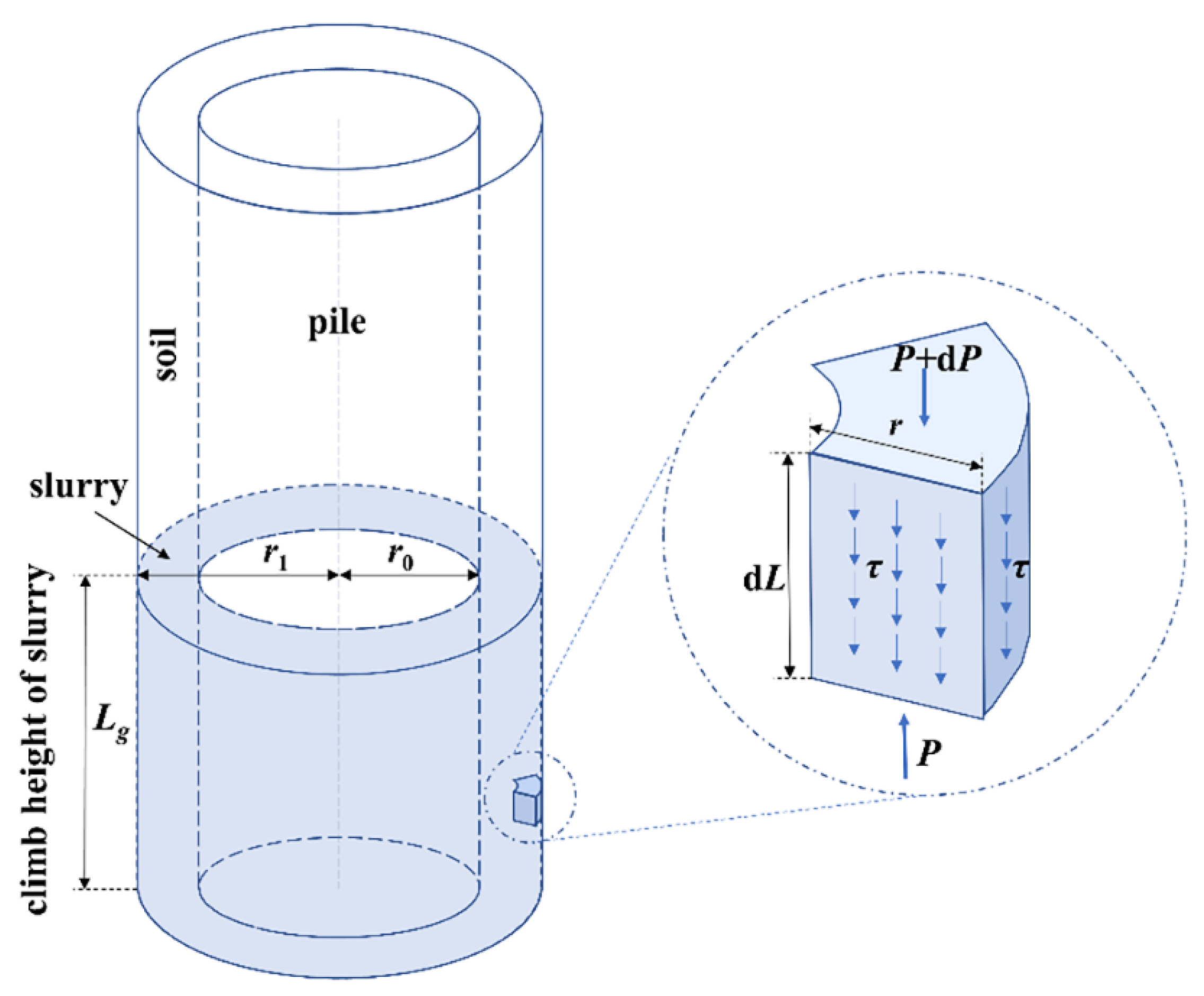
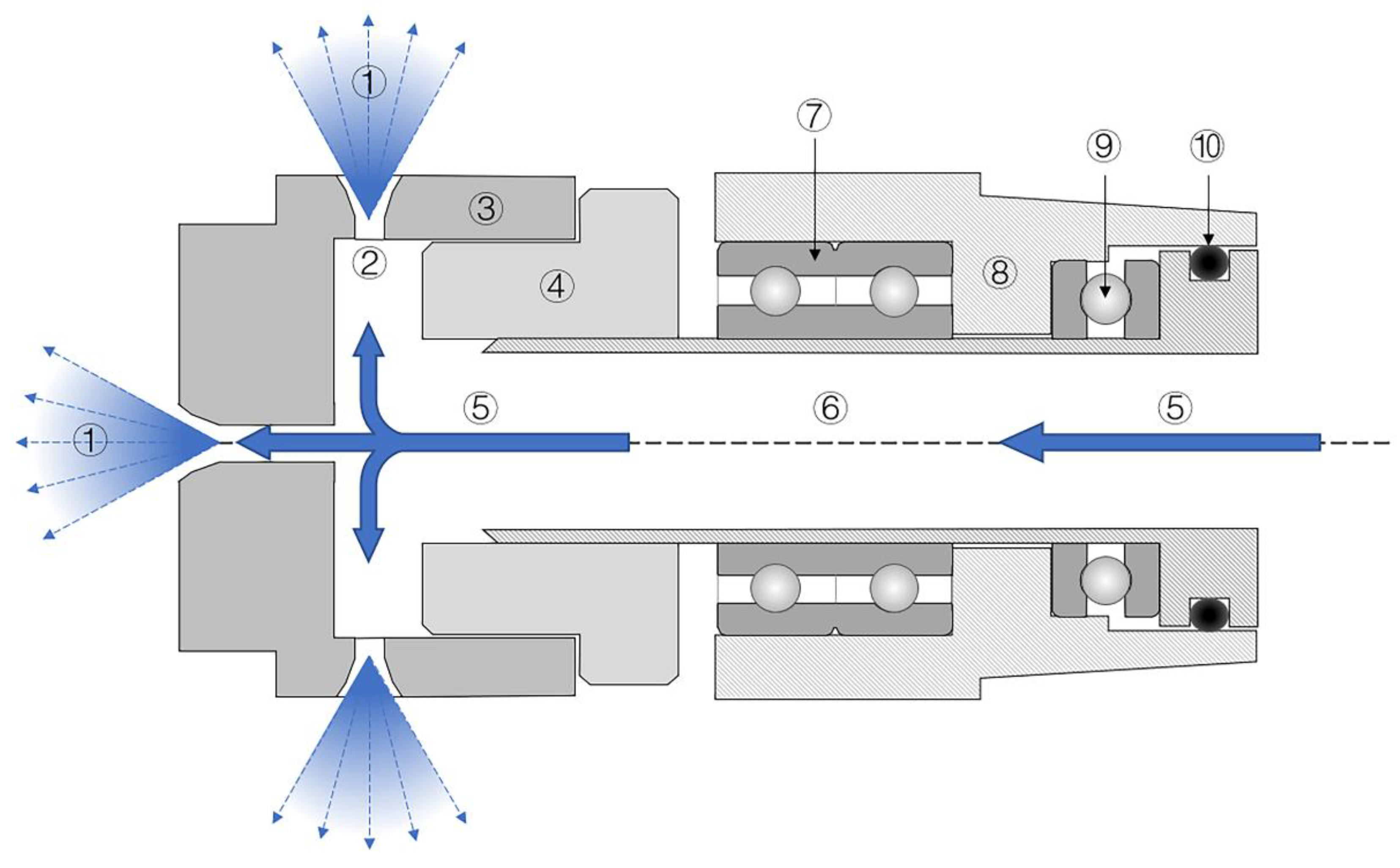
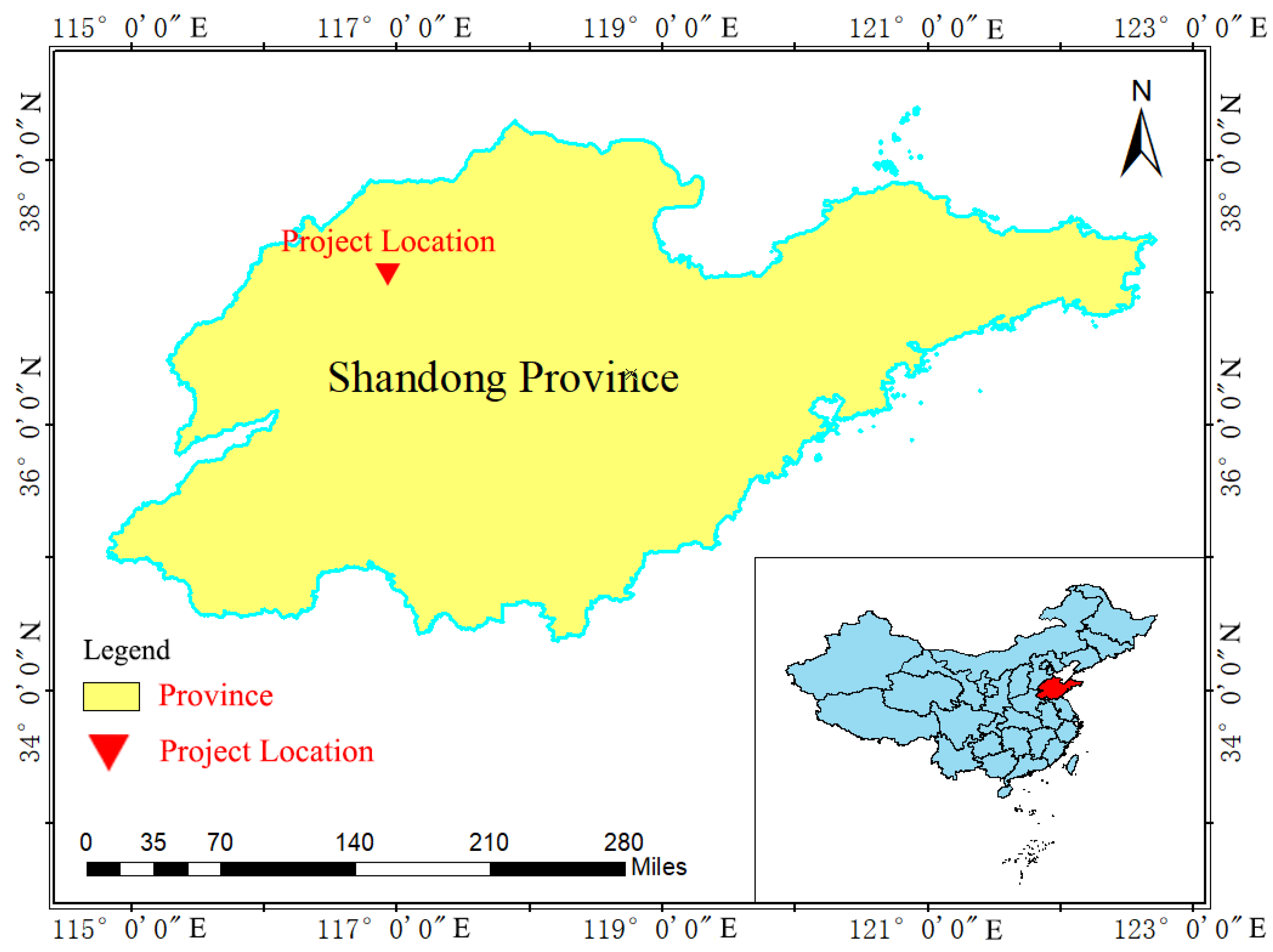
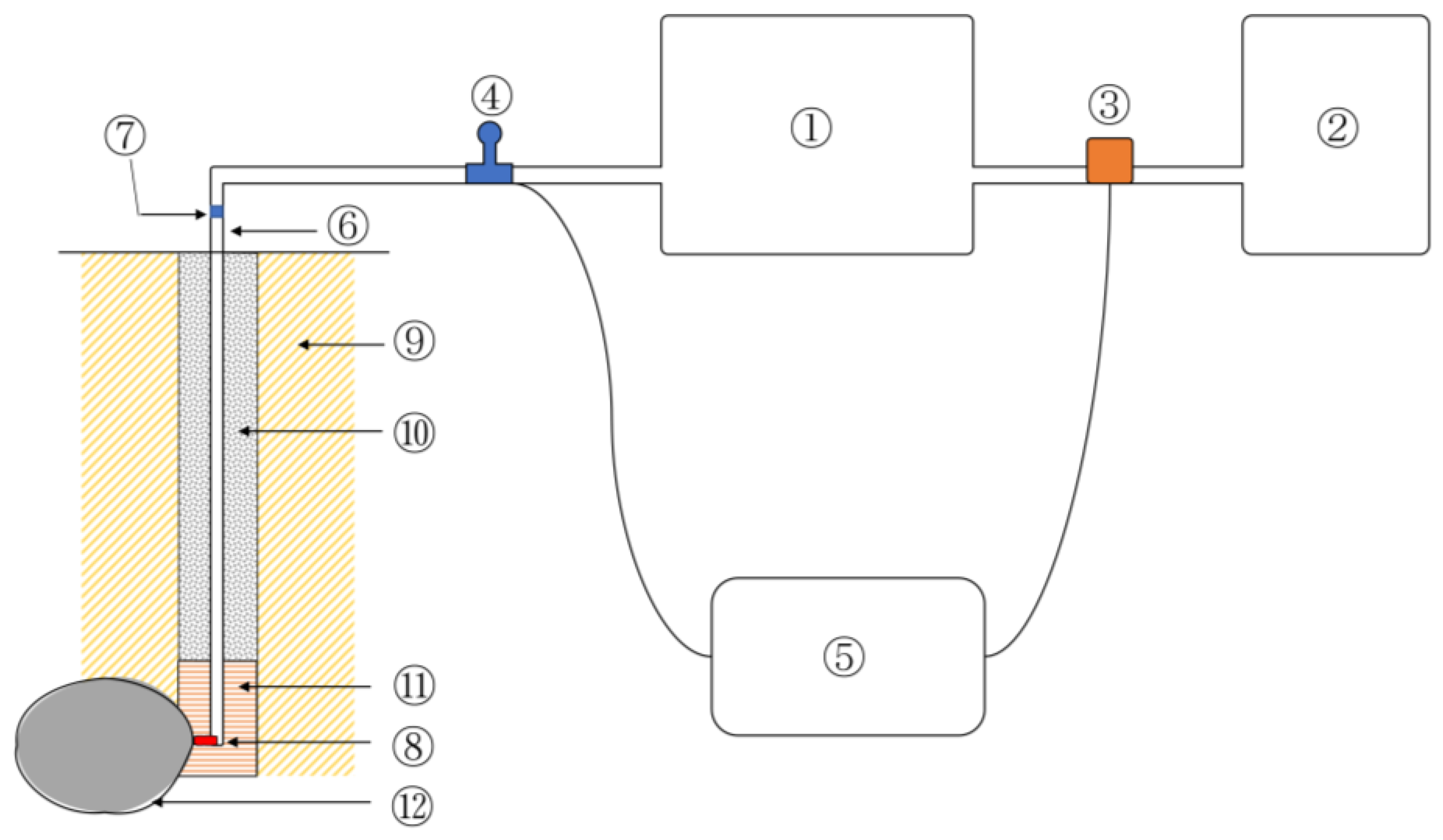
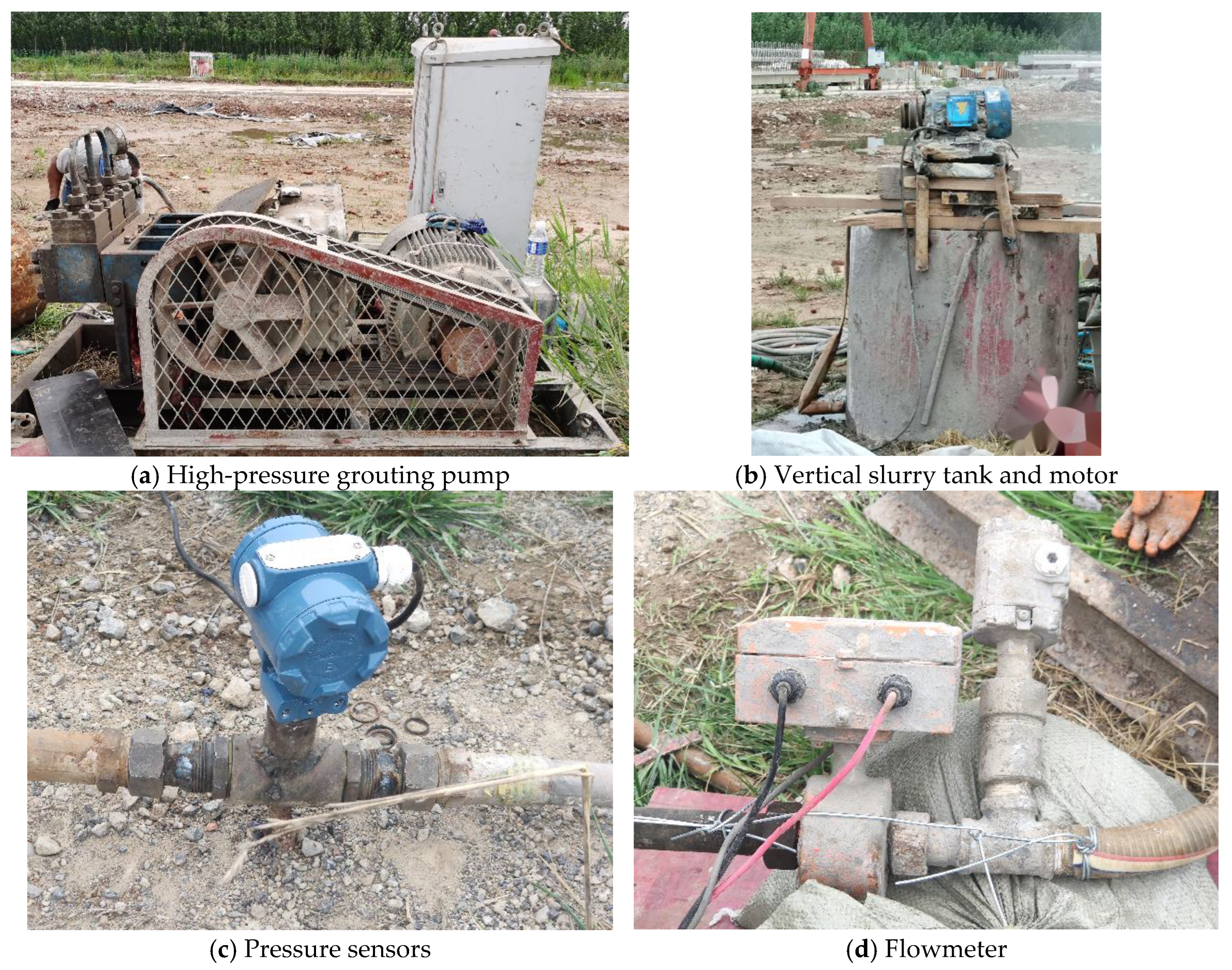
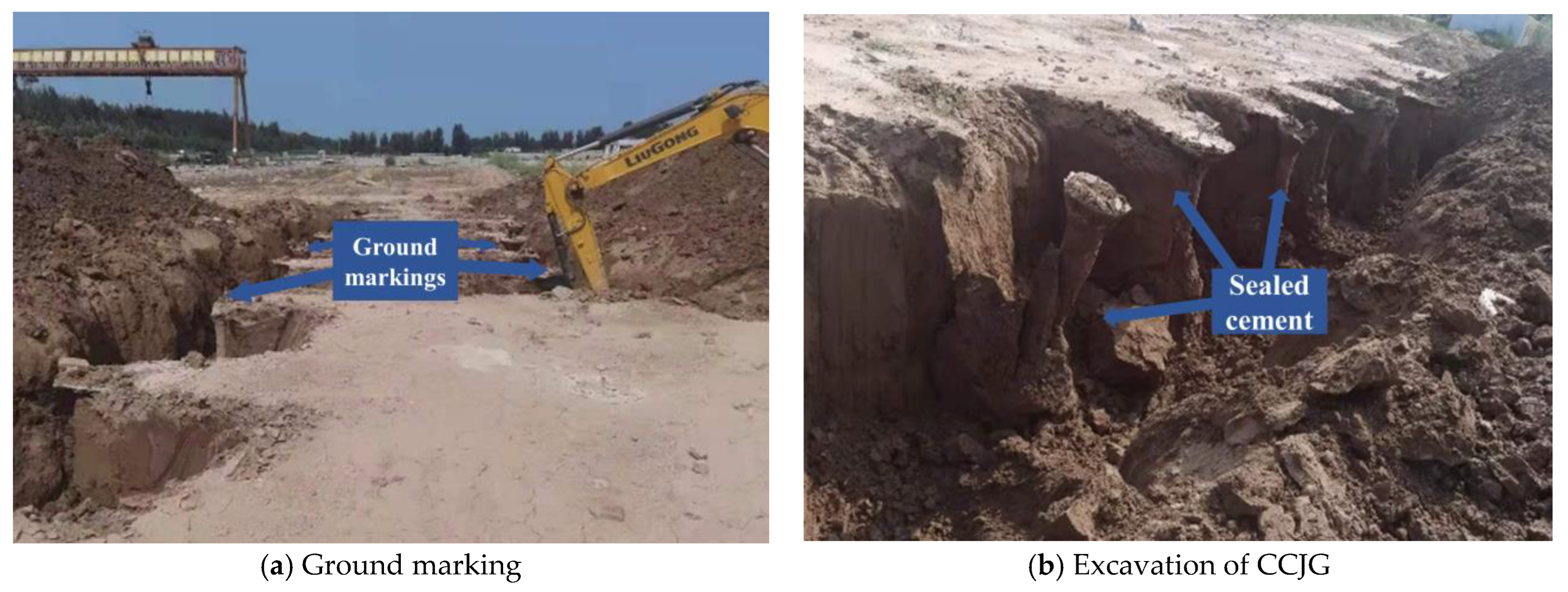
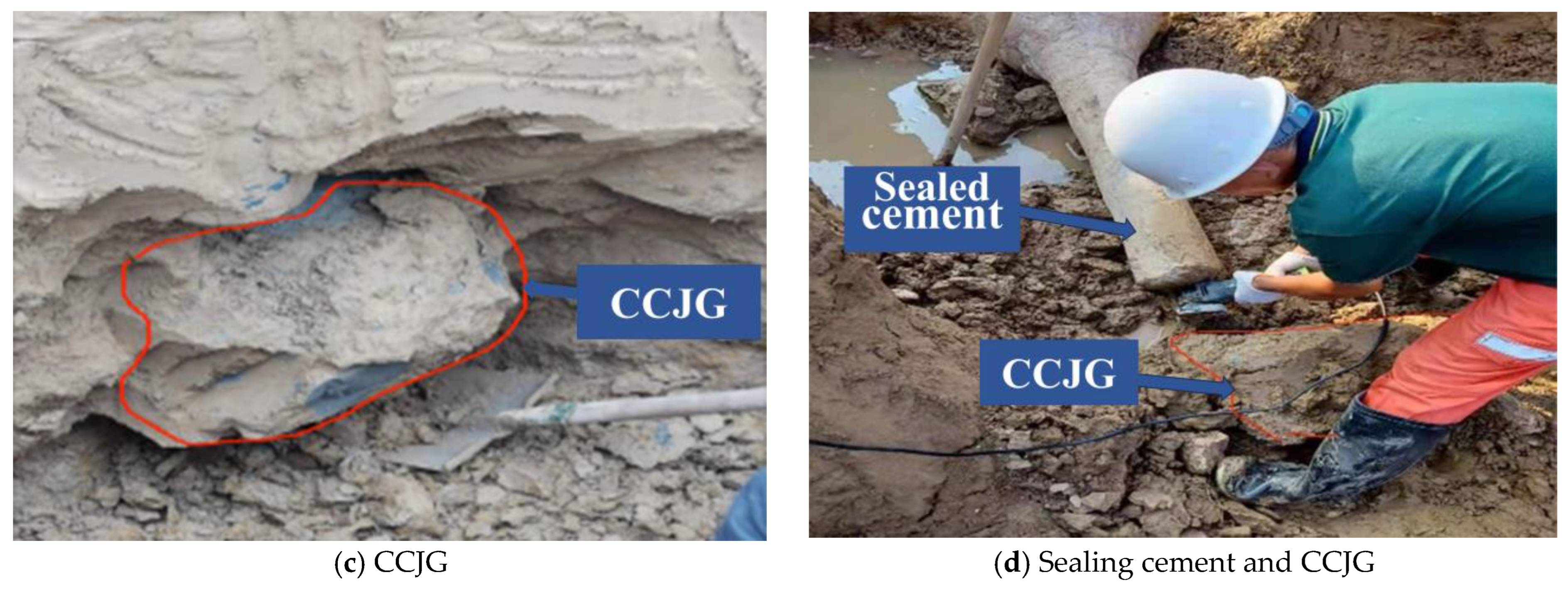
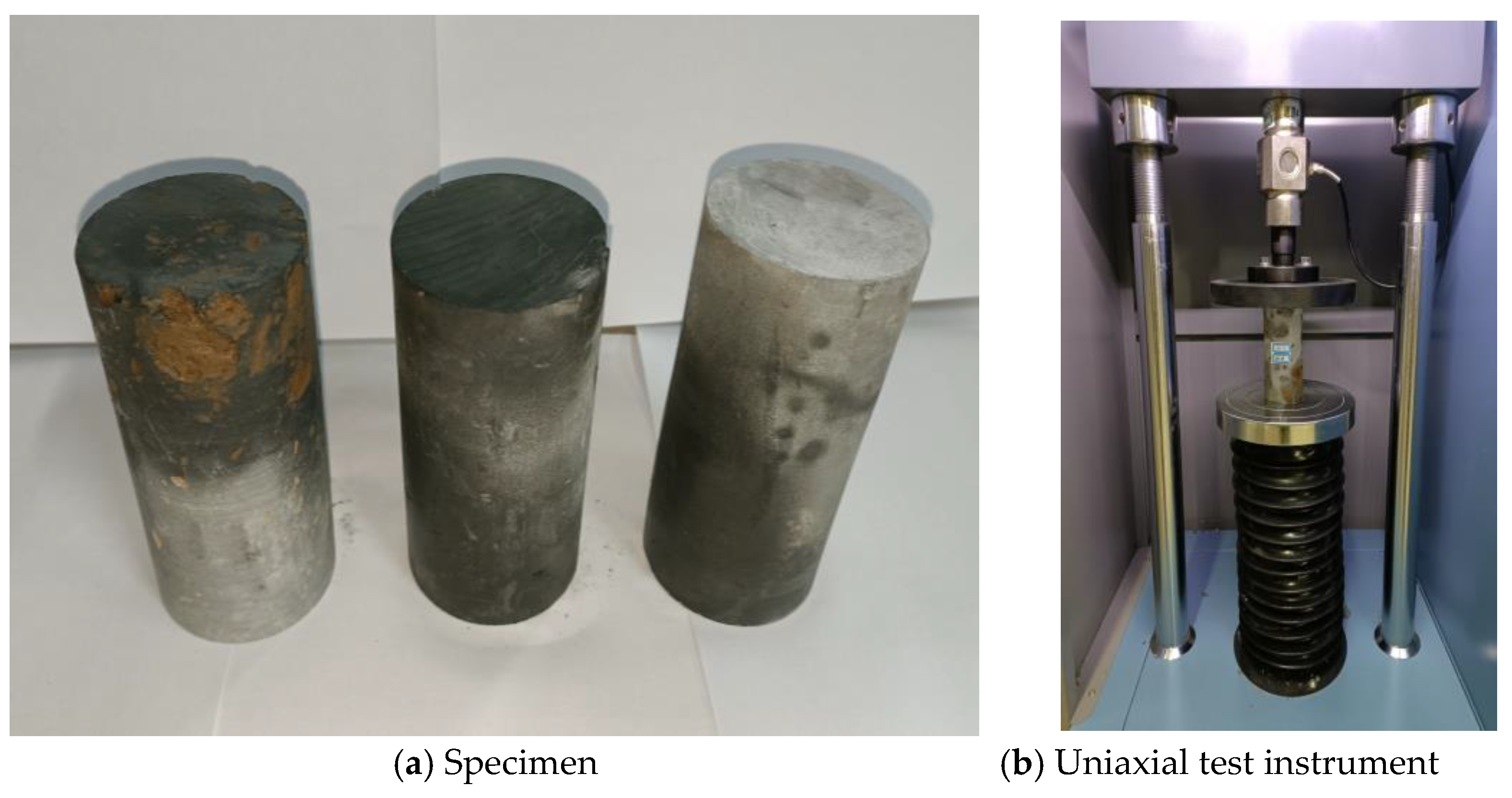
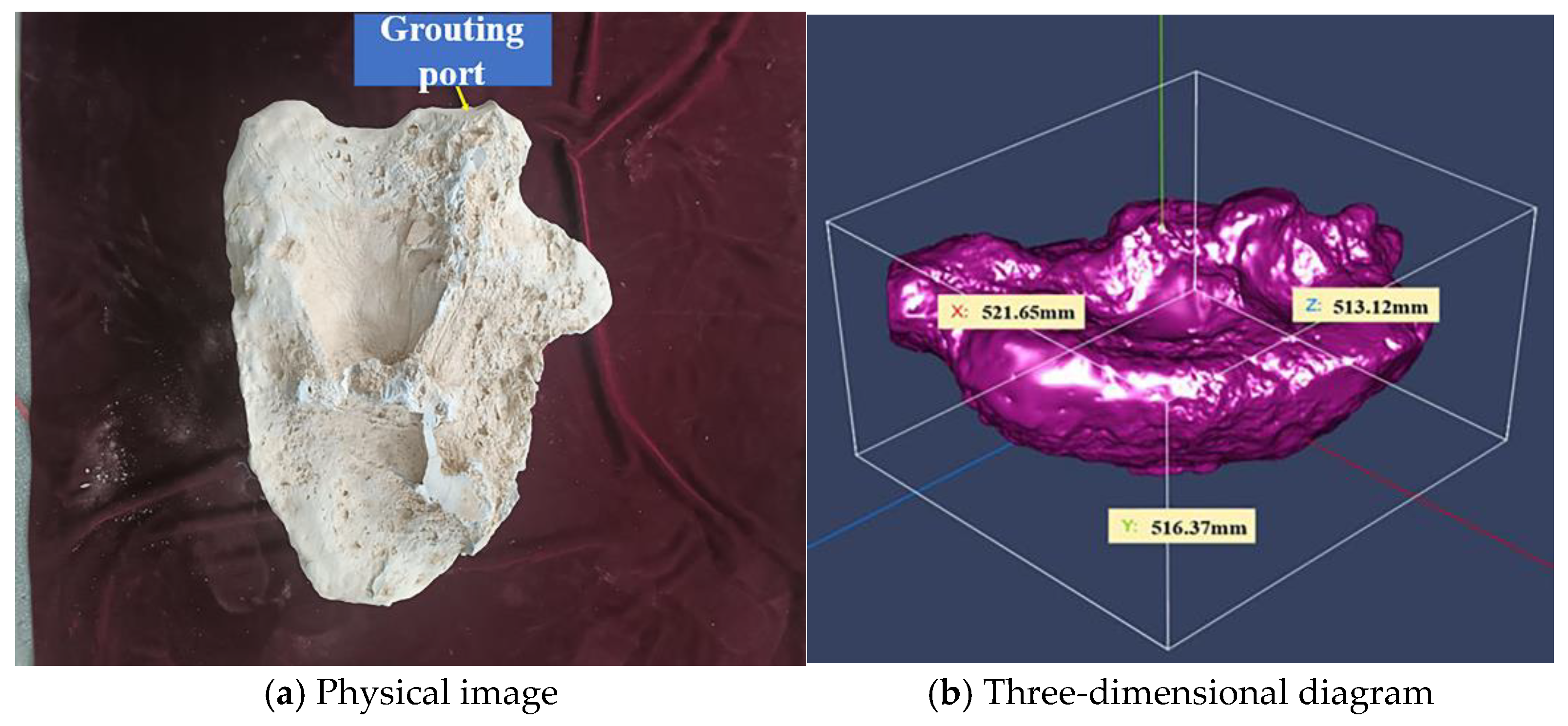
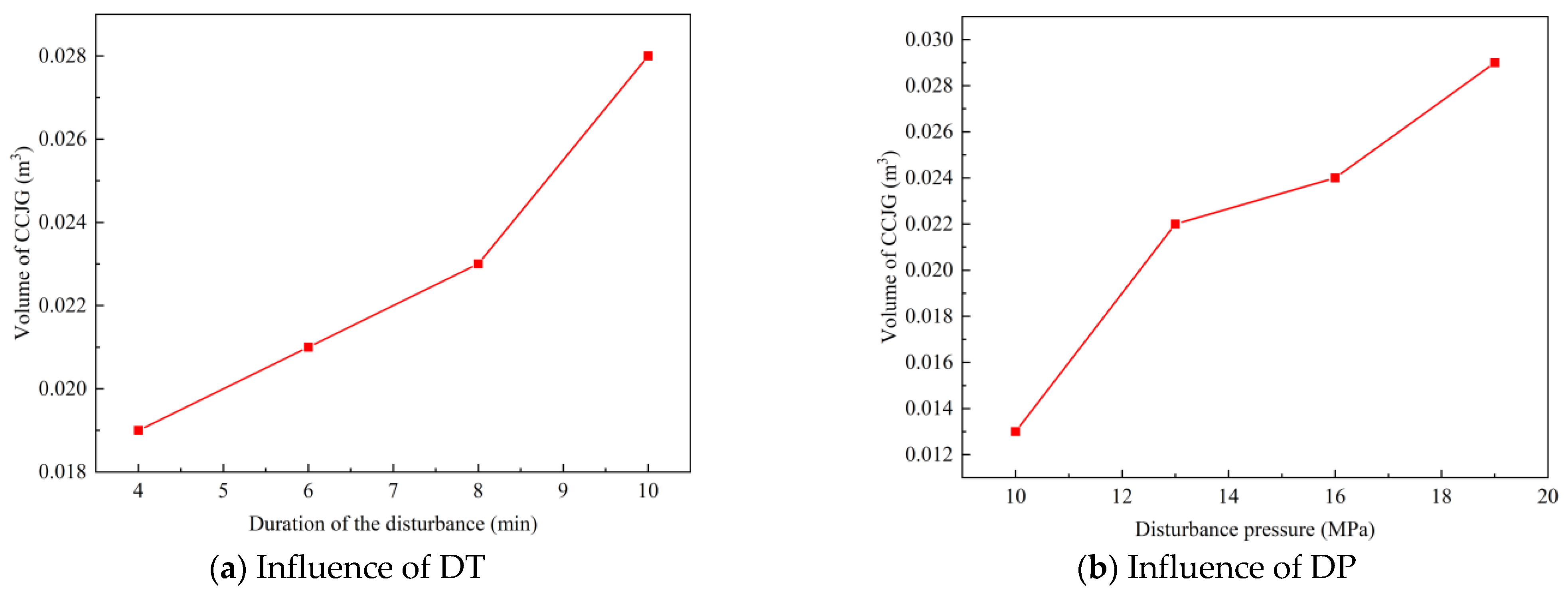
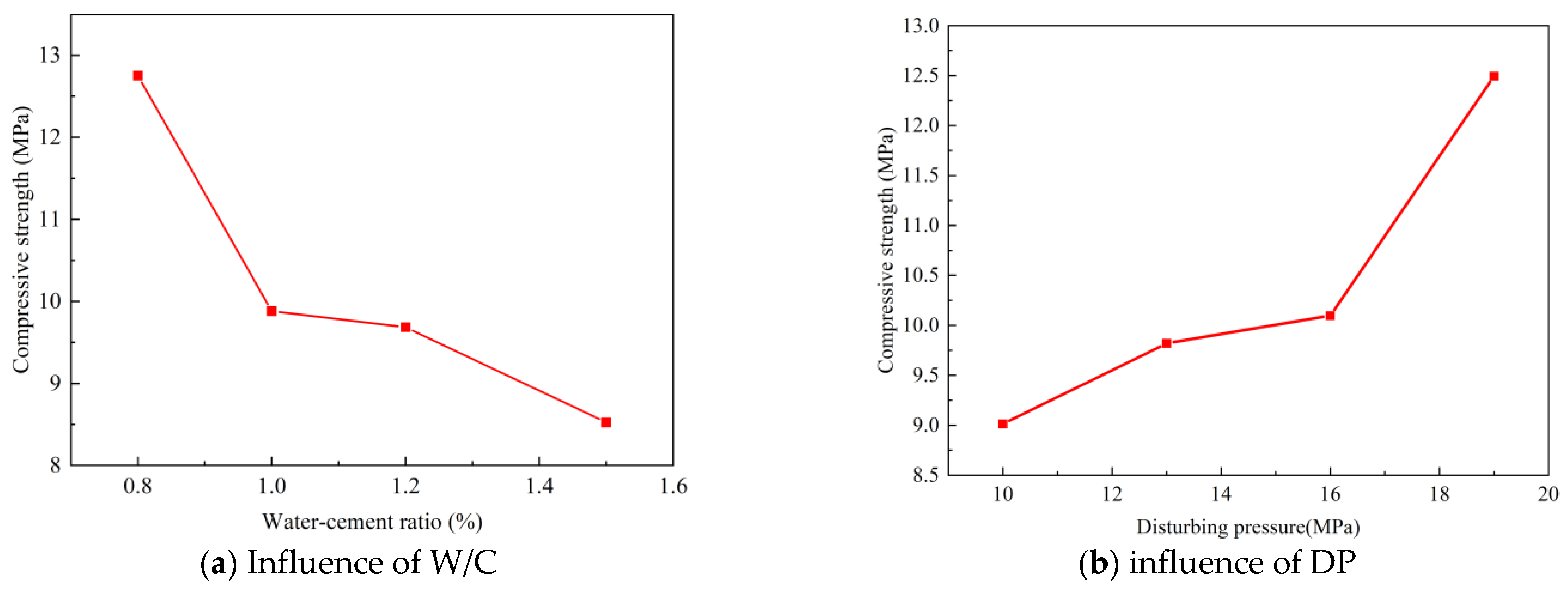
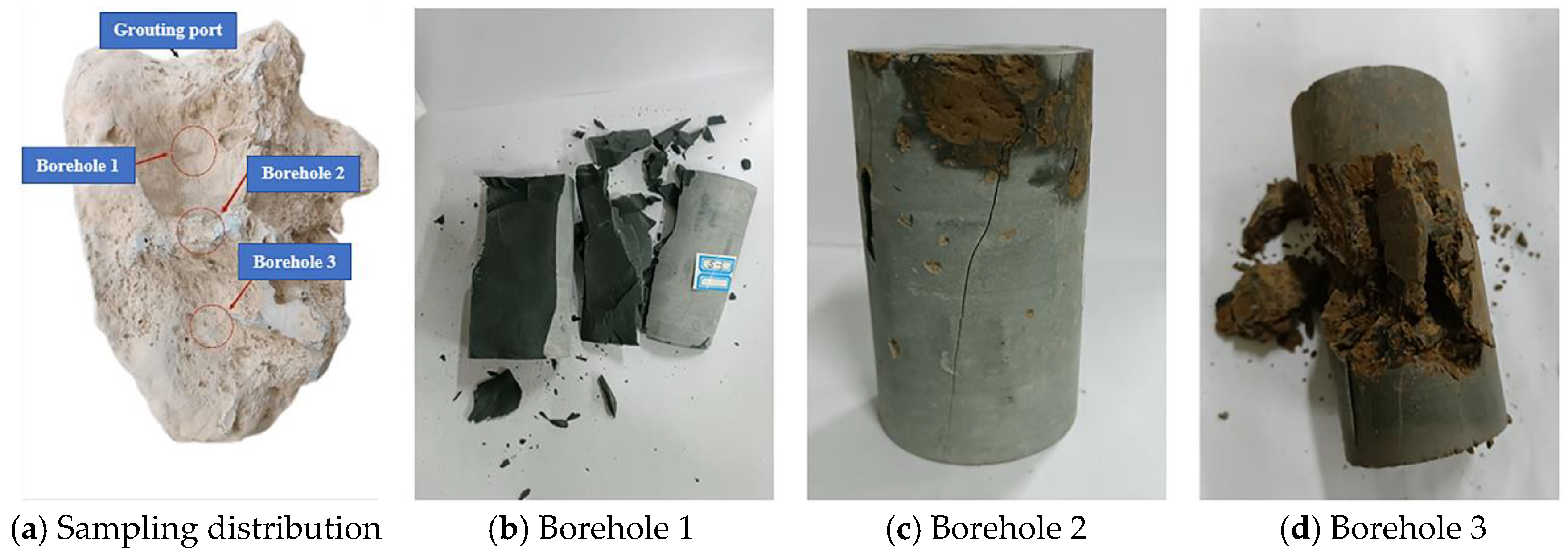
| Specific Gravity Gs | Effective Stress at the Grouting Position (kPa) | Angle of Internal Friction (°) |
|---|---|---|
| 1.82 | 16.2 | 10 |
| Grades | Factors | |||
|---|---|---|---|---|
| DP (MPa) | W/C | GP (MPa) | DT (min) | |
| 1 | 10 | 0.8 | 0.5 | 4 |
| 2 | 13 | 1.0 | 1.0 | 6 |
| 3 | 16 | 1.2 | 1.5 | 8 |
| 4 | 19 | 1.5 | 2.0 | 10 |
| Calculated Value (m) | Average of Actual Value (m) | The Error (%) | |
|---|---|---|---|
| Diameter of the G02 | 0.476 | 0.516 | 7.7% |
| Diameter of the G05 | 0.557 | 0.596 | 6.5% |
| Diameter of the G12 | 0.607 | 0.651 | 6.8% |
| No. | Influence Factors | Test Results | ||||
|---|---|---|---|---|---|---|
| DP (MPa) | W/C | GP (MPa) | DT (min) | Volume (m3) | Strength (MPa) | |
| G01 | 10 | 0.8 | 0.5 | 4 | 0.005 | 7.9 |
| G02 | 10 | 1.0 | 2.0 | 8 | 0.015 | 10.4 |
| G03 | 10 | 1.2 | 1.0 | 10 | 0.023 | 12.7 |
| G04 | 10 | 1.5 | 1.5 | 6 | 0.008 | 8.5 |
| G05 | 13 | 0.8 | 1.0 | 6 | 0.023 | 7.5 |
| G06 | 13 | 1.0 | 1.5 | 10 | 0.027 | 13.8 |
| G07 | 13 | 1.2 | 0.5 | 8 | 0.022 | 12.6 |
| G08 | 13 | 1.5 | 2.0 | 4 | 0.017 | 6.9 |
| G09 | 16 | 0.8 | 1.5 | 8 | 0.025 | 9.1 |
| G10 | 16 | 1.0 | 1.0 | 4 | 0.020 | 7.1 |
| G11 | 16 | 1.2 | 2.0 | 6 | 0.022 | 11.6 |
| G12 | 16 | 1.5 | 0.5 | 10 | 0.029 | 8.7 |
| G13 | 19 | 0.8 | 2.0 | 10 | 0.034 | 11.7 |
| G14 | 19 | 1.0 | 0.5 | 6 | 0.028 | 10.5 |
| G15 | 19 | 1.2 | 1.5 | 4 | 0.023 | 14.3 |
| G16 | 19 | 1.5 | 1.0 | 8 | 0.030 | 10.7 |
| Factor | A | B | C | D |
|---|---|---|---|---|
| DP (MPa) | GP (MPa) | DT (min) | W/C | |
| 1 | 0.013 | 0.021 | 0.019 | 0.022 |
| 2 | 0.022 | 0.024 | 0.021 | 0.023 |
| 3 | 0.024 | 0.021 | 0.023 | 0.023 |
| 4 | 0.029 | 0.023 | 0.028 | 0.022 |
| R | 0.016 | 0.003 | 0.009 | 0.001 |
| Optimal level | 4 | 2 | 4 | 3 |
| Best match | A4B2C4D3 | |||
| Order | DP > DT > GP > W/C | |||
| Factors | A | B | C | D |
|---|---|---|---|---|
| DP (MPa) | GP (MPa) | DT (min) | W/C (%) | |
| 1 | 9.014 | 9.887 | 8.992 | 12.752 |
| 2 | 9.820 | 9.359 | 9.492 | 9.884 |
| 3 | 10.098 | 11.350 | 10.441 | 9.686 |
| 4 | 12.494 | 10.752 | 12.424 | 8.526 |
| R | 3.480 | 1.991 | 3.432 | 4.226 |
| Optimal level | 4 | 3 | 4 | 1 |
| Best match | A4B3C4D1 | |||
| order | W/C > DT > DP > GP | |||
Disclaimer/Publisher’s Note: The statements, opinions and data contained in all publications are solely those of the individual author(s) and contributor(s) and not of MDPI and/or the editor(s). MDPI and/or the editor(s) disclaim responsibility for any injury to people or property resulting from any ideas, methods, instructions or products referred to in the content. |
© 2024 by the authors. Licensee MDPI, Basel, Switzerland. This article is an open access article distributed under the terms and conditions of the Creative Commons Attribution (CC BY) license (https://creativecommons.org/licenses/by/4.0/).
Share and Cite
Zhang, J.; Xu, Y.; Wu, D.; Liu, C.; Cheng, G.; Gao, Q.; Ren, Z.; Guo, C. Study on the Diffusion Parameters of Newtonian Fluid in High-Pressure Jet Disturbance Grouting. Buildings 2024, 14, 1491. https://doi.org/10.3390/buildings14061491
Zhang J, Xu Y, Wu D, Liu C, Cheng G, Gao Q, Ren Z, Guo C. Study on the Diffusion Parameters of Newtonian Fluid in High-Pressure Jet Disturbance Grouting. Buildings. 2024; 14(6):1491. https://doi.org/10.3390/buildings14061491
Chicago/Turabian StyleZhang, Jian, Yikai Xu, Duohua Wu, Chuanxiao Liu, Guangtan Cheng, Qiang Gao, Zhe Ren, and Changle Guo. 2024. "Study on the Diffusion Parameters of Newtonian Fluid in High-Pressure Jet Disturbance Grouting" Buildings 14, no. 6: 1491. https://doi.org/10.3390/buildings14061491
APA StyleZhang, J., Xu, Y., Wu, D., Liu, C., Cheng, G., Gao, Q., Ren, Z., & Guo, C. (2024). Study on the Diffusion Parameters of Newtonian Fluid in High-Pressure Jet Disturbance Grouting. Buildings, 14(6), 1491. https://doi.org/10.3390/buildings14061491






